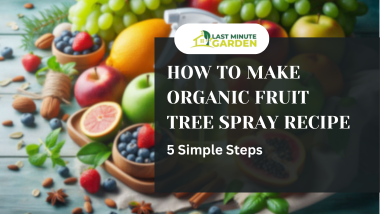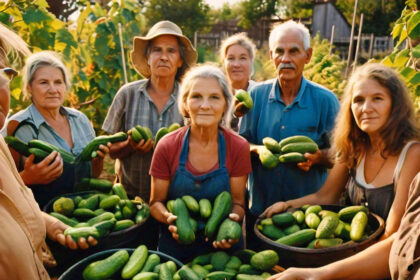Growing fruit trees is a rewarding endeavor, but pests and diseases can threaten your harvest. Luckily, creating your own organic fruit tree spray can help protect your trees naturally!
Growing fruit trees involves ensuring they stay healthy and productive. Organic sprays are one of the best ways to protect your trees from pests and diseases without harmful chemicals.
In this guide, I’ll walk you through making a powerful yet gentle organic fruit tree spray recipe in just five steps. If you’re managing a backyard orchard or a few potted trees, this homemade spray will give you peace of mind, knowing you’re using a safe, natural solution. Let’s get into it!
Step 1: Gather Your Ingredients

The foundation of any effective organic fruit tree spray recipe starts with simple, natural ingredients. Here’s what you’ll need:
Neem Oil: Known for its broad-spectrum pest control, Neem oil works wonders against a variety of pests. Make sure to use 100% cold-pressed Neem oil.
Castile Soap: This gentle soap helps break down oils and lets the spray stick to leaves, making it harder for pests to escape the treatment.
Garlic or peppermint oil: Both are excellent at deterring pests. Garlic oil is great for repelling insects, while peppermint is known to disrupt their natural cycles.
Water: Plain water dilutes the mix to ensure it’s not too harsh on the tree but still effective.
Together, these ingredients create a balanced, natural spray that’s tough on pests but gentle on your fruit trees.
Step 2: Mix the Ingredients
Once you’ve gathered your ingredients, it’s time to mix them in the correct proportions. Follow these guidelines for the right balance:
- Neem Oil: Add two tablespoons of neem oil to a spray bottle filled with one gallon of water. Be sure to use pure, cold-pressed neem oil for maximum effectiveness.
- Castile Soap: Add one teaspoon of liquid castile soap to the mix. This helps the spray adhere to leaves and prevents pests from slipping away.
- Essential Oils: If you’re using garlic or peppermint oil, add about 10-15 drops. Garlic’s strong scent deters pests, while peppermint is great for keeping caterpillars and aphids at bay.
Give your bottle a good shake to ensure everything is well-mixed. You’ll want to mix the solution fresh before each application to keep it potent and effective.
Step 3: Test the Spray on a Small Area
Before you spray your entire tree, it’s wise to test the solution on a small area. Pick a few leaves on the tree and apply a light mist. Wait 24 hours to see how the leaves respond.
This test helps confirm that the mixture won’t cause leaf burn or other adverse reactions on your tree.
If the test area looks good and there’s no sign of damage, you’re ready to move on to the full application.
Step 4: Apply the Spray
Timing is everything when it comes to applying organic sprays. Here’s how to do it:
- Best Time to Spray: Early morning or late evening is ideal. Spraying during the heat of the day can cause leaf burn, and applying it during windy times increases the risk of drift.
- Coverage: Spray all parts of the tree, focusing on the undersides of leaves where pests often hide. Start at the top of the tree and work your way down to ensure full coverage.
- Frequency: Reapply the spray every 7-10 days, especially during the active growing season when pests and diseases are most prevalent. Be consistent with your application to maintain a healthy tree.
- Remember, this spray is designed to target pests while being safe for beneficial insects. When applied properly, it won’t harm pollinators like bees.
Step 5: Adjust for the Season
Fruit tree care changes with the seasons, and so should your spray schedule. Here’s how to adjust for optimal results:
- Dormant Season: During winter, a stronger concentration of neem oil or a specific dormant oil can be applied to combat overwintering pests and diseases.
- Growing Season: As fruit begins to develop, use a lighter concentration and avoid spraying directly onto blossoms to protect pollinators.
- Peak Harvest: Cut back on spraying close to harvest. This ensures that fruit remains clean and free from any lingering residue when picked.
- With this simple adjustment, you’re not only treating your trees with what they need, but you’re also maximizing the spray’s effectiveness across the seasons.
Tips for Success and Safety
Using organic sprays means you’re making a conscious choice to avoid chemicals, but it’s still important to handle sprays with care. Here are a few key tips for success:
Protect Yourself: Wear gloves, a long-sleeved shirt, and glasses to prevent the spray from getting on your skin or in your eyes.
Store Your Ingredients Properly: Neem oil, castile soap, and essential oils all need to be stored in a cool, dark place to stay fresh and effective.
Dispose of Extra Mixture Safely: Avoid dumping any leftover spray in areas where it might harm beneficial soil organisms.
Why Organic Fruit Tree Spray Recipes Are Worth It
Choosing an organic approach to pest management offers more than just peace of mind. Not only do you protect your harvest from potentially harmful chemicals, but you’re also preserving the natural balance within your garden.
Organic fruit tree spray recipes let you nurture your trees while respecting beneficial insects, soil health, and the broader environment.
Incorporating organic fruit tree sprays into your routine can make all the difference, promoting healthier, pest-resistant trees and better harvests. With this five-step organic fruit tree spray recipe and a bit of dedication, your trees will thrive, and so will your orchard.
Give this DIY spray a try, and watch how your trees respond. With each spray, you’re not just combating pests—you’re creating a healthier ecosystem right in your backyard. Enjoy the bounty of your organic fruit harvest!





